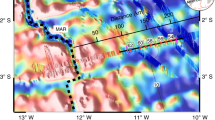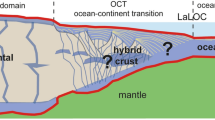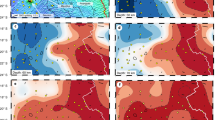Abstract
The lithosphere–asthenosphere boundary is the most extensive boundary on Earth, separating the mobile plate above from the convecting mantle below, but its nature remains a matter of debate. Using an ultra-deep seismic reflection technique, here we show a systematic seismic image of two deep reflectors that we interpret as the upper and lower limits of the lithosphere–asthenosphere boundary beneath a 40–70-million-year-old oceanic lithosphere in the Atlantic Ocean. These two reflections correspond to 1,260 °C and 1,355 °C isotherms and bound a low-velocity channel, suggesting that the lithosphere–asthenosphere boundary is thermally controlled. We observe a clear age dependency of this sublithospheric channel: its depth increases with age from 72 km where it is 40-Myr-old to 88 km where it is 70-Myr-old, whereas its thickness decreases with age from 18 km to 12 km. We suggest that partial melting, facilitated by water, is the main mechanism responsible for the low-velocity channel. The required water concentration for melting increases with age; nevertheless, its corresponding total mass remains relatively constant, suggesting that most of the volatiles in the oceanic sublithospheric channel originate from a horizontal flux near the ridge axis.
This is a preview of subscription content, access via your institution
Access options
Access Nature and 54 other Nature Portfolio journals
Get Nature+, our best-value online-access subscription
$29.99 / 30 days
cancel any time
Subscribe to this journal
Receive 12 print issues and online access
$259.00 per year
only $21.58 per issue
Buy this article
- Purchase on Springer Link
- Instant access to full article PDF
Prices may be subject to local taxes which are calculated during checkout




Similar content being viewed by others
References
Eaton, D. W. et al. The elusive lithosphere-asthenosphere boundary (LAB) beneath cratons. Lithos 109, 1–22 (2009).
Priestley, K. & McKenzie, D. The thermal structure of the lithosphere from shear wave velocities. Earth Planet. Sci. Lett. 244, 285–301 (2006).
Burgos, G. et al. Oceanic lithosphere-asthenosphere boundary from surface wave dispersion data. J. Geophys. Res. Solid Earth 119, 1079–1093 (2014).
Kawakatsu, H. et al. Seismic evidence for sharp lithosphere-asthenosphere boundaries of oceanic plates. Science 324, 499–502 (2009).
Rychert, C. A. & Shearer, P. M. Imaging the lithosphere-asthenosphere boundary beneath the Pacific using SS waveform modeling. J. Geophys. Res. Solid Earth 116, Q0AK10 (2011).
Olugboji, T. M., Park, J., Karato, S. I. & Shinohara, M. Nature of the seismic lithosphere-asthenosphere boundary within normal oceanic mantle from high-resolution receiver functions. Geochem. Geophys. Geosyst. 17, 1265–1282 (2016).
Tharimena, S., Rychert, C. A. & Harmon, N. Seismic imaging of a mid-lithospheric discontinuity beneath Ontong Java Plateau. Earth Planet. Sci. Lett. 450, 62–70 (2016).
Stern, T. A. et al. A seismic reflection image for the base of a tectonic plate. Nature 518, 85 (2015).
Karato, S. I. On the origin of the asthenosphere. Earth Planet. Sci. Lett. 321, 95–103 (2012).
Hirschmann, M. M. Partial melt in the oceanic low velocity zone. Phys. Earth Planet. Inter. 179, 60–71 (2010).
Machida, S., Kogiso, T. & Hirano, N. Petit-spot as definitive evidence for partial melting in the asthenosphere caused by CO2. Nat. Commun. 8, 14302 (2017).
Tharimena, S., Rychert, C. & Harmon, N. A unified continental thickness from seismology and diamonds suggests a melt-defined plate. Science 357, 580–583 (2017).
Darros De Matos, R. M. Atlantic Rifts and Continental Margins (American Geophysical Union, Washington, DC, 2000); 331–354.
Müller, R. D., Sdrolias, M., Gaina, C. & Roest, W. R. Age, spreading rates, and spreading asymmetry of the world’s ocean crust. Geochem. Geophys. Geosyst. 9, Q04006 (2008).
White, R. S., McKenzie, D. & O’Nions, R. K. Oceanic crustal thickness from seismic measurements and rare earth element inversions. J. Geophys. Res. Solid Earth 97, 19683–19715 (1992).
Pasyanos, M., Masters, T., Laske, G. & Ma, Z. LITHO1.0: An updated crust and lithospheric model of the Earth. J. Geophys. Res. Solid Earth 119, 2153–2173 (2014).
Stein, C. A. & Stein, S. A model for the global variation in oceanic depth and heat flow with lithospheric age. Nature 359, 123–129 (1992).
McKenzie, D., Jackson, J. & Priestley, K. Thermal structure of oceanic and continental lithosphere. Earth Planet. Sci. Lett. 233, 337–349 (2005).
Sarafian, E., Gaetani, G. A., Hauri, E. H. & Sarafian, A. R. Experimental constraints on the damp peridotite solidus and oceanic mantle potential temperature. Science 355, 942–945 (2017).
Naif, S., Key, K., Constable, S. & Evans, R. L. Melt-rich channel observed at the lithosphere–asthenosphere boundary. Nature 495, 356 (2013).
Faul, U. H. & Jackson, I. The seismological signature of temperature and grain size variations in the upper mantle. Earth Planet. Sci. Lett. 234, 119–134 (2005).
Ghahremani, F. Effect of grain boundary sliding on anelasticity of polycrystals. Int. J. Solids Struct. 16, 825–845 (1980).
Taylor, M. A. J. & Singh, S. C. Composition and microstructure of magma bodies from effective medium theory. Geophys. J. Int. 149, 15–21 (2002).
Holtzman, B. K. & Kohlstedt, D. L. Stress-driven melt segregation and strain partitioning in partially molten rocks: Effects of stress and strain. J. Petrol. 48, 2379–2406 (2007).
Hirschmann, M. M., Tenner, T., Aubaud, C. & Withers, A. C. Dehydration melting of nominally anhydrous mantle: The primacy of partitioning. Phys. Earth Planet. Int. 176, 54–68 (2009).
Katz, R. F., Spiegelman, M. & Langmuir, C. H. A new parameterization of hydrous mantle melting. Geochem. Geophys. Geosyst. 4, 1073 (2003).
Masuti, S., Barbot, S. D., Karato, S. I., Feng, L. & Banerjee, P. Upper-mantle water stratification inferred from observations of the 2012 Indian Ocean earthquake. Nature 538, 373–377 (2016).
McKenzie, D. The generation and compaction of partially molten rock. J. Petrol. 25, 713–765 (1984).
Asimow, P. D. & Langmuir, C. H. The importance of water to oceanic mantle melting regimes. Nature 421, 815 (2003).
Keller, T., Katz, R. F. & Hirschmann, M. M. Volatiles beneath mid-ocean ridges: Deep melting, channelised transport, focusing, and metasomatism. Earth Planet. Sci. Lett. 464, 55–68 (2017).
Keller, T. & Katz, R. F. The role of volatiles in reactive melt transport in the asthenosphere. J. Petrology 57, 1073–1108 (2016).
Plank, T. & Langmuir, C. H. Effects of the melting regime on the composition of the oceanic crust. J. Geophys. Res. Solid Earth 97, 19749–19770 (1992).
Michael, P. Regionally distinctive sources of depleted MORB: Evidence from trace elements and H2O. Earth Planet. Sci. Lett. 131, 301–320 (1995).
Danyushevsky, L. V., Eggins, S. M., Falloon, T. J. & Christie, D. M. H2O abundance in depleted to moderately enriched mid-ocean ridge magmas; part I: incompatible behaviour, implications for mantle storage, and origin of regional variations. J. Petrol. 41, 1329–1364 (2000).
Sobolev, A. V. & Chaussidon, M. H2O concentrations in primary melts from supra-subduction zones and mid-ocean ridges: implications for H2O storage and recycling in the mantle. Earth Planet. Sci. Lett. 137, 45–55 (1996).
Précigout, J., Prigent, C., Palasse, L. & Pochon, A. Water pumping in mantle shear zones. Nat. Commun. 8, 15736 (2017).
Schmerr, N. The Gutenberg discontinuity: Melt at the lithosphere-asthenosphere boundary. Science 335, 1480–1483 (2012).
Takei, Y. & Holtzman, B. K. Viscous constitutive relations of solid-liquid composites in terms of grain boundary contiguity: 1. Grain boundary diffusion control model. J. Geophys. Res. Solid Earth 114, B06205 (2009).
Murton, B. J. Anomalous oceanic lithosphere formed in a leaky transform fault: evidence from the Western Limassol Forest Complex, Cyprus. J. Geol. Soc. 143, 845–854 (1986).
Machida, S. et al. Regional mantle heterogeneity regulates melt production along the Réunion hotspot-influenced Central Indian Ridge. Geochem. J. 48, 433–449 (2014).
Vassallo, M., Eggenberger, K., van Manen, D. J., Özbek, A. & Watterson, P. Broadband and beyond with marine towed streamers. Leading Edge 32, 1356–1365 (2013).
Bekara, M. & Van der Baan, M. Random and coherent noise attenuation by empirical mode decomposition. Geophysics 74, V89–V98 (2009).
Qin, Y. & Singh, S. C. Seismic evidence of a two-layer lithospheric deformation in the Indian Ocean. Nat. Commun. 6, 8298 (2015).
Abers, G. A. & Hacker, B. R. A MATLAB toolbox and Excel workbook for calculating the densities, seismic wave speeds, and major element composition of minerals and rocks at pressure and temperature. Geochem. Geophys. Geosyst. 17, 616 (2016).
Clark, A. N., Lesher, C. E., Jacobsen, S. D. & Wang, Y. Anomalous density and elastic properties of basalt at high pressure: Reevaluating of the effect of melt fraction on seismic velocity in the Earth’s crust and upper mantle. J. Geophys. Res. Solid Earth 121, 4232–4248 (2016).
Dasgupta, R. et al. Carbon-dioxide-rich silicate melt in the Earth’s upper mantle. Nature 493, 211 (2013).
McCarthy, C. & Takei, Y. Anelasticity and viscosity of partially molten rock analogue: Toward seismic detection of small quantities of melt. Geophys. Res. Lett. 38, L18306 (2011).
Hirth, G. & Kohlstedt, D. L. Water in the oceanic upper mantle: implications for rheology, melt extraction and the evolution of the lithosphere. Earth Planet. Sci. Lett. 144, 93–108 (1996).
Acknowledgements
The research leading to these results has received funding from the European Research Council under the European Union’s Seventh Framework Programme (FP7/2007–2013)/ERC Advance Grant agreement no. 339442_TransAtlanticILAB. The discussions with C. Langmuir on petrology were extremely useful. This manuscript was substantially improved in response to the thoughtful suggestions of B. Romanowicz and C. Langmuir. T. Stern provided a very constructive review. This is an Intitut de Physique du Globe de Paris contribution number 3899.
Author information
Authors and Affiliations
Contributions
S.C.S. designed the project, led the data acquisition, supervised F.M. and wrote the paper. F.M. processed the seismic data, carried out all the calculations, produced the figures and participated in the writing of the paper.
Corresponding author
Ethics declarations
Competing interests
The authors declare no competing financial interests.
Additional information
Publisher’s note: Springer Nature remains neutral with regard to jurisdictional claims in published maps and institutional affiliations.
Supplementary information
Supplementary Information
Supplementary figures.
Rights and permissions
About this article
Cite this article
Mehouachi, F., Singh, S.C. Water-rich sublithospheric melt channel in the equatorial Atlantic Ocean. Nature Geosci 11, 65–69 (2018). https://doi.org/10.1038/s41561-017-0034-z
Received:
Accepted:
Published:
Issue Date:
DOI: https://doi.org/10.1038/s41561-017-0034-z
This article is cited by
-
Deep hydration and lithospheric thinning at oceanic transform plate boundaries
Nature Geoscience (2022)
-
A plume origin for hydrous melt at the lithosphere–asthenosphere boundary
Nature (2022)
-
Discovery of flat seismic reflections in the mantle beneath the young Juan de Fuca Plate
Nature Communications (2020)



